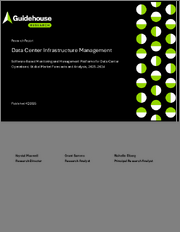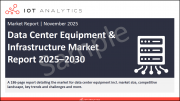
|
시장보고서
상품코드
1677123
세계의 양자 데이터센터 시장(2025-2030년) : 솔루션, 양자 컴포넌트, 냉각 기술, 기업 규모, 최종 사용자별 예측Quantum-Enabled Data Centers Market by Solution, Quantum Component, Cooling Technology, Enterprise Size, End User - Global Forecast 2025-2030 |
||||||
양자 데이터센터 시장은 2024년에는 3억 9,377만 달러를 달성하였고 CAGR 22.14%로 성장하여 2025년에는 4억 7,780만 달러, 2030년에는 13억 740만 달러에 이를 것으로 예측되고 있습니다.
| 주요 시장 통계 | |
|---|---|
| 기준연도(2024) | 3억 9,377만 달러 |
| 추정연도(2025) | 4억 7,780만 달러 |
| 예측연도(2030) | 13억 740만 달러 |
| CAGR(%) | 22.14% |
양자 데이터센터는 데이터 처리와 스토리지 능력의 획기적인 진화를 의미합니다. 이러한 센터는 전통적인 IT 인프라의 단순한 확장이 아니라 양자 컴퓨팅 구성 요소와 전통적인 데이터센터 아키텍처를 종합적으로 통합한 결과입니다. 양자 알고리즘과 고성능 하드웨어의 융합은 속도, 보안 및 확장성을 크게 향상시킵니다.
양자 컴퓨팅의 등장은 대량 데이터의 처리, 분석, 보안의 방식을 근본적으로 바꾸고 있습니다. 이 분야의 리더들은 양자역학의 가능성을 활용하여 컴퓨팅 패러다임을 변화시켜 업무의 회복력과 효율성을 높이고 있습니다. 양자역학과 고전적인 솔루션의 장점을 활용하는 하이브리드 접근법을 채택함으로써 기업은 컴퓨팅 능력을 향상시키고 견고한 데이터 관리에 대한 길을 열어 나가고 있습니다.
데이터가 경쟁 우위의 통화가 되는 시대에 있어서, 양자 속도로 정보를 처리하는 능력은 혁명적일 뿐만 아니라 필수 불가결한 것입니다. 디지털 전환에 대응할 수 있는 데이터센터 서비스에 대한 세계 수요가 높아지고 있는 가운데, 이해관계자는 현재 양자기술을 전략적 청사진에 통합하는 것에 그 어느 때보다 투자하고 있습니다.
양자 데이터센터 시장의 변화
데이터센터의 상황은 양자 기술 통합의 직접적인 결과로 크게 변화하고 있습니다. 이러한 역동적인 변화는 하드웨어와 소프트웨어 모두에서 혁신이 가속화된 결과로 이전에는 상상할 수 없었던 확장 가능한 솔루션으로 이어졌습니다.
전통적인 데이터센터에 양자 컴퓨팅 기능을 도입함으로써 다계층 혁신이 촉진됩니다. 기존 시스템과 양자 시스템의 융합은 기존의 데이터 처리 속도가 지수적으로 향상되고 더 큰 데이터 세트를 더 높은 신뢰성으로 처리할 수 있는 패러다임을 성장시킵니다. 이 혁명은 단순히 물리적 인프라를 업그레이드할 뿐만 아니라 전체 운영 프레임워크를 검토하는 데 중점을 둡니다.
시장 선두기업들은 첨단 냉각 기술, 저지연 네트워크 장비, 특수 전원 공급 장치, 러기드 서버 구성, 최첨단 스토리지 시스템 등에 투자하고 있으며, 이들은 전체적으로 양자 가속기의 성장을 지원합니다. 포스트양자암호, 양자키분배, 양자 난수 발생기와 같은 양자 구성 요소의 통합은 사이버 보안 수준을 높이고 새로운 위협에 대한 데이터센터의 내성을 향상시킵니다.
게다가 에너지 효율과 운용의 지속 가능성이 중시되면서 냉각 기술에도 혁신이 일어나고 특히 최적의 성능을 확보하기 위한 공냉 및 액냉 방식이 개선되었습니다. 각 산업이 이러한 급속한 진보에 대응하는 가운데, 의사결정자는 기존의 데이터센터 생태계와 첨단 양자기술 사이에 발생하는 시너지 효과를 활용하는데 있어서 그 어느 때보다 유리한 입장에 서 있습니다.
양자 데이터센터의 주요 부문에 대한 인사이트
시장 세분화의 상세한 검증을 통해 양자 데이터센터의 구조와 성장에 기여하는 다양한 측면에 대한 확실한 인사이트를 얻을 수 있습니다. 시장은 솔루션 컴포넌트에 따라 세분화되어 하드웨어, 서비스 및 소프트웨어를 통해 면밀히 조사하였습니다. 하드웨어에서는 냉각 시스템, 네트워크 장비, 전원, 랙, 서버, 스토리지 시스템 등의 요소가 데이터센터의 탄력적인 백본을 구축하는 데 중요합니다. 서비스는 다양하게 분류되며 컨설팅 서비스, 배포 및 통합, 관리 서비스, 지원 및 유지관리 업무 등을 포함합니다. 마찬가지로 소프트웨어 틈새 시장은 백업 및 복구 도구, 컨테이너 오케스트레이션, 데이터센터 관리 솔루션, 보안 애플리케이션, 가상화 플랫폼 등을 운영 패브릭에 통합합니다.
양자 컴포넌트에 기초한 추가 세분화에서는 포스트양자암호, 양자키분배, 양자 난수 생성기의 통합을 검토함으로써, 더 깊은 시장 이해를 제공합니다. 이러한 요소는 첨단 사이버 위협의 영향을 받기 쉬운 환경에서 데이터 보안 및 운영의 무결성을 강화하는 데 필수적입니다. 게다가 냉각기술별로 시장을 조사하여 공냉과 액냉의 두 가지 주요 방법으로 분류하였습니다. 이러한 차별화는 효율과 환경 배려의 균형을 고려한 최적의 열 관리 솔루션을 선택하는 중요성을 강조합니다.
세분화는 기업 규모에 따라 대기업과 중소기업의 요구를 충족시키는 솔루션을 제공합니다. 최종 사용자용도의 폭은 자동차, 은행, 금융 서비스, 교육, 연구, 에너지, 유틸리티, 의료, IT, 통신, 제조, 소매, 전자상거래 등 다양한 분야에 걸쳐 있습니다. 이 다면적 세분화는 기술 개발을 특정 산업 요구 사항에 맞추는 데 도움이 되는 실용적인 인사이트를 제공하며, 궁극적으로 종합적이고 적응력 있는 시장 프레임워크를 구축합니다.
목차
제1장 서문
제2장 조사 방법
제3장 주요 요약
제4장 시장 개요
제5장 시장 인사이트
- 시장 역학
- 성장 촉진요인
- 디지털화의 진전과 데이터 주도의 혁신에 의해 데이터 용량 수요가 증가
- 분야를 넘어 새로운 시장 기회를 창출하는 양자 연구 개발에 대한 투자 증가
- 복잡한 데이터 분석을 위한 양자 알고리즘을 통합한 클라우드 컴퓨팅 서비스 확대
- 억제요인
- 양자 기술의 데이터센터 통합에 필요한 높은 비용
- 기회
- 현대의 데이터센터에 양자 및 기존 하이브리드 아키텍처를 채용하여 에너지 소비를 최적화
- 양자 기술 공급업체와 데이터센터 사업자 간 협력을 통해 안전한 처리 솔루션을 통합
- 과제
- 양자 데이터센터와 관련된 데이터의 프라이버시 및 보안 우려
- 성장 촉진요인
- 시장 세분화 분석
- 솔루션 : 양자 프로세서 간의 안전하고 신뢰할 수 있는 통신을 보장하기 위한 하드웨어의 중요성
- 최종 사용자 : 대규모 조직에서 확장 IT 인프라에 대해 증가하는 양자 데이터센터 수요
- Porter's Five Forces 분석
- PESTEL 분석
- 정치
- 경제
- 사회
- 기술
- 법률
- 환경
제6장 양자 데이터센터 시장 : 솔루션별
- 하드웨어
- 냉각시스템
- 네트워크기기
- 전원
- 랙
- 서버
- 스토리지시스템
- 서비스
- 컨설팅 서비스
- 배포 및 통합
- 매니지드 서비스
- 지원 및 유지보수 서비스
- 소프트웨어
- 백업 및 복구 소프트웨어
- 컨테이너 오케스트레이션 도구
- 데이터센터 관리 소프트웨어
- 보안 솔루션
- 가상화 소프트웨어
제7장 양자 데이터센터 시장 : 양자 컴포넌트별
- 포스트양자암호(PQC)
- 양자키분배(QKD)
- 양자 난수 생성기(QRNG)
제8장 양자 데이터센터 시장 : 냉각 기술별
- 공냉식
- 액냉식
제9장 양자 데이터센터 시장 : 기업 규모별
- 대기업
- 중소기업
제10장 양자 데이터센터 시장 : 최종 사용자별
- 자동차
- 은행 및 금융 서비스
- 교육 및 연구
- 에너지 및 유틸리티
- 헬스케어
- IT 및 통신
- 제조업
- 소매 및 E-Commerce
제11장 아메리카 양자 데이터센터 시장
- 아르헨티나
- 브라질
- 캐나다
- 멕시코
- 미국
제12장 아시아태평양의 양자 데이터센터 시장
- 호주
- 중국
- 인도
- 인도네시아
- 일본
- 말레이시아
- 필리핀
- 싱가포르
- 한국
- 대만
- 태국
- 베트남
제13장 유럽, 중동 및 아프리카 양자 데이터센터 시장
- 덴마크
- 이집트
- 핀란드
- 프랑스
- 독일
- 이스라엘
- 이탈리아
- 네덜란드
- 나이지리아
- 노르웨이
- 폴란드
- 카타르
- 러시아
- 사우디아라비아
- 남아프리카
- 스페인
- 스웨덴
- 스위스
- 터키
- 아랍에미리트(UAE)
- 영국
제14장 경쟁 구도
- 시장 점유율 분석(2024)
- FPNV 포지셔닝 매트릭스(2024)
- 경쟁 시나리오 분석
- 전략 분석과 제안
기업 목록
- Atos SE
- D-Wave Quantum Inc.
- Google LLC
- Innogress
- International Business Machines Corporation
- IonQ, Inc.
- IQM Quantum Computers
- NEC Corporation
- Oxford Instruments plc
- Q-CTRL Pty Ltd
- QuEra Computing Inc.
- Toshiba Corporation
- Xanadu Quantum Technologies Inc.
The Quantum-Enabled Data Centers Market was valued at USD 393.77 million in 2024 and is projected to grow to USD 477.80 million in 2025, with a CAGR of 22.14%, reaching USD 1,307.40 million by 2030.
| KEY MARKET STATISTICS | |
|---|---|
| Base Year [2024] | USD 393.77 million |
| Estimated Year [2025] | USD 477.80 million |
| Forecast Year [2030] | USD 1,307.40 million |
| CAGR (%) | 22.14% |
Quantum-enabled data centers represent a groundbreaking evolution in data processing and storage capabilities. These centers are not just extensions of traditional IT infrastructure but a holistic integration of quantum computing components with classical data center architectures. The rapidly shifting technological landscape has pushed data centers to adopt quantum-native strategies, where the fusion of quantum algorithms and high-performance hardware creates substantial improvements in speed, security, and scalability.
The emergence of quantum computing is fundamentally reshaping how large volumes of data are handled, analyzed, and secured. Leaders in the field are harnessing the potential of quantum mechanics to transform computing paradigms, thereby ensuring that operations become more resilient and efficient. By embracing a hybrid approach that leverages the strengths of both quantum and classical solutions, organizations are paving the way for enhanced computational power and robust data management.
In an age where data is the currency of competitive advantage, the ability to process information at quantum speeds is not only revolutionary but essential. With increasing global demand for data center services that can keep pace with digital transformation, stakeholders are now more invested than ever in integrating quantum technologies into their strategic blueprints.
Transformative Shifts in the Landscape
The data center landscape is undergoing transformative shifts as a direct consequence of quantum technology integration. These dynamic changes are the result of accelerating innovation in both hardware and software fronts, leading to scalable solutions that were previously unimaginable.
The infusion of quantum computing capabilities into conventional data centers is driving innovation across multiple layers. The convergence of classical and quantum systems is fostering a paradigm where traditional data processing speeds are exponentially enhanced, allowing for the handling of larger datasets with improved reliability. This revolution has shifted the emphasis from merely upgrading physical infrastructure to rethinking the entire operational framework.
Market leaders are investing in advanced cooling techniques, low-latency networking devices, specialized power supplies, robust server configurations, and cutting-edge storage systems that collectively underpin the rise of quantum accelerators. The integration of quantum components-such as post-quantum cryptography, quantum key distribution, and quantum random number generators-has raised the bar for cybersecurity, making data centers more resilient against emerging threats.
In addition, the emphasis on energy efficiency and operational sustainability has prompted innovations in cooling technology, notably through refined air and liquid cooling methods that ensure optimal performance. As industries adapt to these rapid advancements, decision-makers are better positioned than ever to capitalize on the emerging synergies between traditional data center ecosystems and pioneering quantum technologies.
Key Segmentation Insights for Quantum-Enabled Data Centers
A detailed examination of market segmentation offers robust insights into how quantum-enabled data centers are structured and the various dimensions contributing to their growth. The market is segmented based on solution components, where it is meticulously studied across hardware, services, and software. Within hardware, elements including cooling systems, networking devices, power supplies, racks, servers, and storage systems are critical in establishing the resilient backbone of data centers. Services are equally diverse, encompassing consulting services, deployment and integration, managed services, and support and maintenance operations. Equally important is the software niche, which integrates backup and recovery tools, container orchestration, data center management solutions, security applications, and virtualization platforms into the operational fabric.
Further segmentation based on quantum components refines the market understanding by examining the integration of post-quantum cryptography, quantum key distribution, and quantum random number generators. These elements are vital in enhancing data security and operational integrity in an environment increasingly susceptible to sophisticated cyber threats. Additionally, examining the market on the basis of cooling technology reveals two primary methodologies: air cooling and liquid cooling. Such differentiation underscores the importance of selecting optimal thermal management solutions that balance efficiency with environmental considerations.
The segmentation also extends into enterprise size, with tailored solutions addressing the needs of large organizations alongside small and medium sized enterprises. The breadth of end-user applications spans diverse sectors such as automotive, banking and financial services, education and research, energy and utilities, healthcare, IT and telecommunication, manufacturing, and retail and e-commerce. This multi-faceted segmentation provides actionable insights that help in aligning technology deployment with specific industry requirements, ultimately creating a well-rounded and adaptive market framework.
Based on Solution, market is studied across Hardware, Services, and Software. The Hardware is further studied across Cooling Systems, Networking Devices, Power Supply, Racks, Servers, and Storage Systems. The Services is further studied across Consulting Services, Deployment & Integration, Managed Services, and Support & Maintenance Services. The Software is further studied across Backup & Recovery Software, Container Orchestration Tools, Data Center Management Software, Security Solutions, and Virtualization Software.
Based on Quantum Component, market is studied across Post-Quantum Cryptography (PQC), Quantum Key Distribution (QKD), and Quantum Random Number Generators (QRNG).
Based on Cooling Technology, market is studied across Air Cooling and Liquid Cooling.
Based on Enterprise Size, market is studied across Large Size Organizations and Small & Medium Sized Organizations.
Based on End User, market is studied across Automotive, Banking & Financial Services, Education & Research, Energy & Utilities, Healthcare, IT & Telecommunication, Manufacturing, and Retail & E-Commerce.
Key Regional Insights Shaping Market Dynamics
An analysis of global regional dynamics reveals critical variations in market adoption and technological advancements across different geographic areas. The Americas have demonstrated rapid implementation of quantum-enabled solutions, driven by robust investments in technology and infrastructure modernization. This region continues to lead in the integration of state-of-the-art data center designs with emerging quantum technologies.
In the combined region comprising Europe, the Middle East, and Africa, historical expertise in data management and a steady stream of research and development efforts have led to the adoption of bespoke solutions that match regional needs. These regions showcase a blend of traditional operational models enhanced by modern quantum integration. Meanwhile, the Asia-Pacific region is witnessing accelerated growth, thanks to its vibrant technology ecosystems, substantial public-private investment, and a dynamic market that is quick to adapt and implement new innovations.
Each of these regions presents unique opportunities and challenges, with local market dynamics influenced by distinct regulatory frameworks, economic conditions, and technological readiness. When viewed collectively, the regional insights illustrate that a balanced global approach must account for varied growth trajectories, culturally influenced adoption patterns, and localized innovations that overall contribute to the global momentum of quantum-enabled data centers.
Based on Region, market is studied across Americas, Asia-Pacific, and Europe, Middle East & Africa. The Americas is further studied across Argentina, Brazil, Canada, Mexico, and United States. The United States is further studied across California, Florida, Illinois, New York, Ohio, Pennsylvania, and Texas. The Asia-Pacific is further studied across Australia, China, India, Indonesia, Japan, Malaysia, Philippines, Singapore, South Korea, Taiwan, Thailand, and Vietnam. The Europe, Middle East & Africa is further studied across Denmark, Egypt, Finland, France, Germany, Israel, Italy, Netherlands, Nigeria, Norway, Poland, Qatar, Russia, Saudi Arabia, South Africa, Spain, Sweden, Switzerland, Turkey, United Arab Emirates, and United Kingdom.
Key Companies Driving Innovation
Several pioneering organizations are at the forefront of revolutionizing the quantum-enabled data center landscape. Notable industry influencers include Atos SE, which leverages extensive research capabilities to enhance data processing efficiencies. D-Wave Quantum Inc. plays a pivotal role with its groundbreaking quantum annealing technologies, pushing the boundaries of conventional computing limits. Google LLC's significant investments and research in quantum supremacy further underscore the transformative potential of integrating quantum computing into data centers.
Additionally, companies like Innogress and International Business Machines Corporation drive innovation through comprehensive service integrations and infrastructure optimizations. IonQ, Inc. and IQM Quantum Computers are instrumental in devising next-generation quantum systems that redefine performance benchmarks, while NEC Corporation continuously refines its hardware and software ecosystems. Oxford Instruments plc pioneers critical technological solutions that enhance operational precision and reliability.
Furthermore, Q-CTRL Pty Ltd and QuEra Computing Inc. contribute with sophisticated quantum control and measurement solutions that optimize system performance. Toshiba Corporation's extensive legacy in hardware development complements modern advancements, and Xanadu Quantum Technologies Inc. has emerged as a trailblazer in photonic quantum computing. These leading companies collectively forge the pathway for enhanced operational capabilities and strategic growth, setting industry standards that inspire innovation and investment across the global data center landscape.
The report delves into recent significant developments in the Quantum-Enabled Data Centers Market, highlighting leading vendors and their innovative profiles. These include Atos SE, D-Wave Quantum Inc., Google LLC, Innogress, International Business Machines Corporation, IonQ, Inc., IQM Quantum Computers, NEC Corporation, Oxford Instruments plc, Q-CTRL Pty Ltd, QuEra Computing Inc., Toshiba Corporation, and Xanadu Quantum Technologies Inc.. Actionable Recommendations for Industry Leaders
Industry leaders aiming to navigate the evolving landscape of quantum-enabled data centers should adopt a multifaceted approach that combines strategic investments, technological innovation, and agile operational strategies. First, companies should evaluate their existing data center infrastructure to identify areas where quantum technology can be integrated with minimal disruption. It is critical to conduct a thorough assessment of current hardware components, ranging from cooling systems to power supplies, and determine how advanced quantum solutions can optimize performance without escalating energy consumption.
Next, enterprises should prioritize the adoption of specialized software tools that facilitate seamless container orchestration, data management, and security enhancements. Emphasizing the integration of backup and recovery systems alongside virtualization software will ensure that operations remain robust even during transitional phases. Furthermore, an emphasis on managed services and comprehensive support structures will allow organizations to maintain operational continuity while transitioning to hybrid models.
Leaders are encouraged to establish strategic partnerships with technology innovators and research institutions that specialize in quantum advancements. These alliances can accelerate the integration process by merging classical computational strengths with emerging quantum techniques, ultimately creating more resilient and agile operational systems. In planning long-term strategies, it is advisable to address regulatory and compliance issues proactively, especially related to cybersecurity measures enabled by quantum-enhanced protocols.
In summary, an actionable roadmap for industry leaders should encompass infrastructure modernization, software integration, strategic partnerships, and continuous dialogue with regulatory bodies. This cohesive approach will not only prepare organizations for immediate technological shifts but also build a sustainable foundation for future innovations.
Conclusion: Embracing a Quantum Future
The rapid integration of quantum technologies into data center environments signals a pivotal moment in the evolution of data processing and storage methodologies. The trends highlighted in this summary underscore a clear transition from traditional architectures to advanced quantum-enabled systems that promise enhanced performance, increased security, and improved operational efficiency. The segmentation analysis across solution components, quantum technologies, cooling systems, enterprise sizes, and diverse end-user applications provides a comprehensive view of the market dynamics that are shaping this transformation.
Key regional insights reveal significant variations in technological adoption, driven by local market conditions and investment patterns across the Americas, Europe, the Middle East, Africa, and Asia-Pacific. At the same time, industry-leading companies are setting the pace with relentless innovation and collaboration, demonstrating the tangible benefits of integrating quantum technologies into conventional data center operations.
In conclusion, navigating this complex landscape requires both a strategic vision and operational agility. Organizations that proactively invest in modernization and embrace new quantum-enabled solutions will not only secure a competitive advantage but also pave the way for groundbreaking advancements in data management and cybersecurity. The convergence of quantum and classical methodologies heralds a future where efficiency, speed, and resilience are the cornerstones of operational excellence.
Table of Contents
1. Preface
- 1.1. Objectives of the Study
- 1.2. Market Segmentation & Coverage
- 1.3. Years Considered for the Study
- 1.4. Currency & Pricing
- 1.5. Language
- 1.6. Stakeholders
2. Research Methodology
- 2.1. Define: Research Objective
- 2.2. Determine: Research Design
- 2.3. Prepare: Research Instrument
- 2.4. Collect: Data Source
- 2.5. Analyze: Data Interpretation
- 2.6. Formulate: Data Verification
- 2.7. Publish: Research Report
- 2.8. Repeat: Report Update
3. Executive Summary
4. Market Overview
5. Market Insights
- 5.1. Market Dynamics
- 5.1.1. Drivers
- 5.1.1.1. Growing data capacity demands due to increasing digitalization and the shift toward data-driven innovation
- 5.1.1.2. Increased investment in quantum research and development that fosters new market opportunities across sectors
- 5.1.1.3. Expansion of cloud computing services that integrate quantum algorithms for complex data analysis
- 5.1.2. Restraints
- 5.1.2.1. High expenditure needed for integrating quantum technology into data centers
- 5.1.3. Opportunities
- 5.1.3.1. Adoption of hybrid quantum and classical architectures in modern data centers to optimize energy consumption
- 5.1.3.2. Collaborations between quantum technology providers and data center operators to integrate secure processing solutions
- 5.1.4. Challenges
- 5.1.4.1. Data privacy and security concerns associated with quantum enabled data centers
- 5.1.1. Drivers
- 5.2. Market Segmentation Analysis
- 5.2.1. Solution: Significance of hardware to ensure secure and reliable communication between quantum processors
- 5.2.2. End User: Rising demand for quantum-enabled data centers across large organizations for expansive IT infrastructure
- 5.3. Porter's Five Forces Analysis
- 5.3.1. Threat of New Entrants
- 5.3.2. Threat of Substitutes
- 5.3.3. Bargaining Power of Customers
- 5.3.4. Bargaining Power of Suppliers
- 5.3.5. Industry Rivalry
- 5.4. PESTLE Analysis
- 5.4.1. Political
- 5.4.2. Economic
- 5.4.3. Social
- 5.4.4. Technological
- 5.4.5. Legal
- 5.4.6. Environmental
6. Quantum-Enabled Data Centers Market, by Solution
- 6.1. Introduction
- 6.2. Hardware
- 6.2.1. Cooling Systems
- 6.2.2. Networking Devices
- 6.2.3. Power Supply
- 6.2.4. Racks
- 6.2.5. Servers
- 6.2.6. Storage Systems
- 6.3. Services
- 6.3.1. Consulting Services
- 6.3.2. Deployment & Integration
- 6.3.3. Managed Services
- 6.3.4. Support & Maintenance Services
- 6.4. Software
- 6.4.1. Backup & Recovery Software
- 6.4.2. Container Orchestration Tools
- 6.4.3. Data Center Management Software
- 6.4.4. Security Solutions
- 6.4.5. Virtualization Software
7. Quantum-Enabled Data Centers Market, by Quantum Component
- 7.1. Introduction
- 7.2. Post-Quantum Cryptography (PQC)
- 7.3. Quantum Key Distribution (QKD)
- 7.4. Quantum Random Number Generators (QRNG)
8. Quantum-Enabled Data Centers Market, by Cooling Technology
- 8.1. Introduction
- 8.2. Air Cooling
- 8.3. Liquid Cooling
9. Quantum-Enabled Data Centers Market, by Enterprise Size
- 9.1. Introduction
- 9.2. Large Size Organizations
- 9.3. Small & Medium Sized Organizations
10. Quantum-Enabled Data Centers Market, by End User
- 10.1. Introduction
- 10.2. Automotive
- 10.3. Banking & Financial Services
- 10.4. Education & Research
- 10.5. Energy & Utilities
- 10.6. Healthcare
- 10.7. IT & Telecommunication
- 10.8. Manufacturing
- 10.9. Retail & E-Commerce
11. Americas Quantum-Enabled Data Centers Market
- 11.1. Introduction
- 11.2. Argentina
- 11.3. Brazil
- 11.4. Canada
- 11.5. Mexico
- 11.6. United States
12. Asia-Pacific Quantum-Enabled Data Centers Market
- 12.1. Introduction
- 12.2. Australia
- 12.3. China
- 12.4. India
- 12.5. Indonesia
- 12.6. Japan
- 12.7. Malaysia
- 12.8. Philippines
- 12.9. Singapore
- 12.10. South Korea
- 12.11. Taiwan
- 12.12. Thailand
- 12.13. Vietnam
13. Europe, Middle East & Africa Quantum-Enabled Data Centers Market
- 13.1. Introduction
- 13.2. Denmark
- 13.3. Egypt
- 13.4. Finland
- 13.5. France
- 13.6. Germany
- 13.7. Israel
- 13.8. Italy
- 13.9. Netherlands
- 13.10. Nigeria
- 13.11. Norway
- 13.12. Poland
- 13.13. Qatar
- 13.14. Russia
- 13.15. Saudi Arabia
- 13.16. South Africa
- 13.17. Spain
- 13.18. Sweden
- 13.19. Switzerland
- 13.20. Turkey
- 13.21. United Arab Emirates
- 13.22. United Kingdom
14. Competitive Landscape
- 14.1. Market Share Analysis, 2024
- 14.2. FPNV Positioning Matrix, 2024
- 14.3. Competitive Scenario Analysis
- 14.3.1. SoftBank and Quantinuum enter a strategic partnership to integrate quantum computing into data centers
- 14.3.2. VueNow Group and CDoT launch a quantum-secure data center integrating post-quantum cryptography to safeguard critical infrastructure
- 14.3.3. IBM inaugurates its first European quantum data center in Ehningen to deploy Quantum Eagle and Heron systems
- 14.4. Strategy Analysis & Recommendation
Companies Mentioned
- 1. Atos SE
- 2. D-Wave Quantum Inc.
- 3. Google LLC
- 4. Innogress
- 5. International Business Machines Corporation
- 6. IonQ, Inc.
- 7. IQM Quantum Computers
- 8. NEC Corporation
- 9. Oxford Instruments plc
- 10. Q-CTRL Pty Ltd
- 11. QuEra Computing Inc.
- 12. Toshiba Corporation
- 13. Xanadu Quantum Technologies Inc.



















